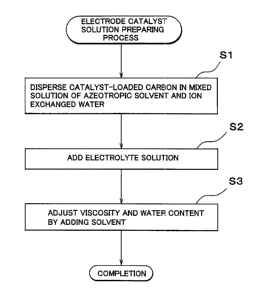Some of the information on this Web page has been provided by external sources. The Government of Canada is not responsible for the accuracy, reliability or currency of the information supplied by external sources. Users wishing to rely upon this information should consult directly with the source of the information. Content provided by external sources is not subject to official languages, privacy and accessibility requirements.
Any discrepancies in the text and image of the Claims and Abstract are due to differing posting times. Text of the Claims and Abstract are posted:
| (12) Patent: | (11) CA 2341565 |
|---|---|
| (54) English Title: | FUEL CELL ELECTRODE CATALYST SOLUTION AND PRODUCTION METHOD THEREFOR |
| (54) French Title: | SOLUTION CATALYTIQUE POUR ELECTRODE DE PILE A COMBUSTIBLE ET METHODE DE PRODUCTION DE CELLE-CI |
| Status: | Expired |
| (51) International Patent Classification (IPC): |
|
|---|---|
| (72) Inventors : |
|
| (73) Owners : |
|
| (71) Applicants : |
|
| (74) Agent: | GOWLING WLG (CANADA) LLP |
| (74) Associate agent: | |
| (45) Issued: | 2004-02-03 |
| (22) Filed Date: | 2001-03-20 |
| (41) Open to Public Inspection: | 2001-09-22 |
| Examination requested: | 2001-03-20 |
| Availability of licence: | N/A |
| (25) Language of filing: | English |
| Patent Cooperation Treaty (PCT): | No |
|---|
| (30) Application Priority Data: | ||||||
|---|---|---|---|---|---|---|
|
The invention improves operability in forming a catalyst electrode, and improves performance of a fuel cell. A catalyst-loaded carbon is dispersed in a mixed solution of an azeotropic solvent and ion exchanged water. An electrolyte solution is added to the dispersed solution. A solvent, such as ethanol or the like, is added to adjust the viscosity and the water content of the solution, thereby providing an electrode catalyst solution. The use of the obtained solution as an ink for forming a catalyst layer through printing improves printing characteristic and drying characteristic.
L'invention améliore la fonctionnalité dans la formation d'une électrode catalytique, et améliore les performances d'une pile à combustible. Un carbone chargé de catalyseur est dispersé dans une solution mélangée d'un solvant azéotropique et une eau dont les ions ont été échangés. Une solution électrolyte est ajoutée à la solution dispersée. Un solvant, tel que l'éthanol ou similaire, est ajouté pour régler la viscosité et le contenu en eau de la solution, fournissant ainsi une solution de catalyseur d'électrode. L'utilisation de la solution obtenue comme une encre pour former une couche de catalyseur à travers l'impression améliore les caractéristiques d'impression et de séchage.
Note: Claims are shown in the official language in which they were submitted.
Note: Descriptions are shown in the official language in which they were submitted.

For a clearer understanding of the status of the application/patent presented on this page, the site Disclaimer , as well as the definitions for Patent , Administrative Status , Maintenance Fee and Payment History should be consulted.
| Title | Date |
|---|---|
| Forecasted Issue Date | 2004-02-03 |
| (22) Filed | 2001-03-20 |
| Examination Requested | 2001-03-20 |
| (41) Open to Public Inspection | 2001-09-22 |
| (45) Issued | 2004-02-03 |
| Expired | 2021-03-22 |
There is no abandonment history.
| Fee Type | Anniversary Year | Due Date | Amount Paid | Paid Date |
|---|---|---|---|---|
| Request for Examination | $400.00 | 2001-03-20 | ||
| Registration of a document - section 124 | $100.00 | 2001-03-20 | ||
| Application Fee | $300.00 | 2001-03-20 | ||
| Maintenance Fee - Application - New Act | 2 | 2003-03-20 | $100.00 | 2003-02-25 |
| Final Fee | $300.00 | 2003-11-24 | ||
| Maintenance Fee - Patent - New Act | 3 | 2004-03-22 | $100.00 | 2004-03-03 |
| Maintenance Fee - Patent - New Act | 4 | 2005-03-21 | $100.00 | 2005-02-08 |
| Maintenance Fee - Patent - New Act | 5 | 2006-03-20 | $200.00 | 2006-02-07 |
| Maintenance Fee - Patent - New Act | 6 | 2007-03-20 | $200.00 | 2007-02-08 |
| Maintenance Fee - Patent - New Act | 7 | 2008-03-20 | $200.00 | 2008-02-08 |
| Maintenance Fee - Patent - New Act | 8 | 2009-03-20 | $200.00 | 2009-02-12 |
| Maintenance Fee - Patent - New Act | 9 | 2010-03-22 | $200.00 | 2010-02-18 |
| Maintenance Fee - Patent - New Act | 10 | 2011-03-21 | $250.00 | 2011-02-17 |
| Maintenance Fee - Patent - New Act | 11 | 2012-03-20 | $250.00 | 2012-02-08 |
| Maintenance Fee - Patent - New Act | 12 | 2013-03-20 | $250.00 | 2013-02-14 |
| Maintenance Fee - Patent - New Act | 13 | 2014-03-20 | $250.00 | 2014-02-13 |
| Maintenance Fee - Patent - New Act | 14 | 2015-03-20 | $250.00 | 2015-02-25 |
| Maintenance Fee - Patent - New Act | 15 | 2016-03-21 | $450.00 | 2016-02-24 |
| Maintenance Fee - Patent - New Act | 16 | 2017-03-20 | $450.00 | 2017-02-22 |
| Maintenance Fee - Patent - New Act | 17 | 2018-03-20 | $450.00 | 2018-03-01 |
| Maintenance Fee - Patent - New Act | 18 | 2019-03-20 | $450.00 | 2019-02-27 |
| Maintenance Fee - Patent - New Act | 19 | 2020-03-20 | $450.00 | 2020-02-26 |
Note: Records showing the ownership history in alphabetical order.
| Current Owners on Record |
|---|
| TOYOTA JIDOSHA KABUSHIKI KAISHA |
| Past Owners on Record |
|---|
| KAWAHARA, TATSUYA |
| MIZUNO, SEIJI |